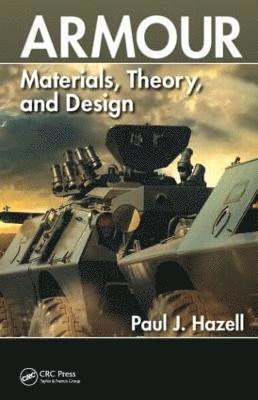
- Format
- Inbunden (Hardback)
- Språk
- Engelska
- Antal sidor
- 395
- Utgivningsdatum
- 2015-07-29
- Förlag
- Apple Academic Press Inc.
- Illustratör/Fotograf
- black and white 163 Illustrations 372 Equations, 1 in text box 68 Tables black and white
- Illustrationer
- 68 Tables, black and white; 163 Illustrations, black and white
- Dimensioner
- 234 x 157 x 25 mm
- Vikt
- Antal komponenter
- 1
- Komponenter
- 52:B&W 6.14 x 9.21in or 234 x 156mm (Royal 8vo) Case Laminate on White w/Gloss Lam
- ISBN
- 9781482238297
- 676 g
Armour
Materials, Theory, and Design
Kundrecensioner
Fler böcker av Paul J Hazell
-
Story of the Gun
Paul J Hazell
This engaging and accessible book explains the scientific principles behind guns, both ancient and modern. It connects their evolution to advances in science, as well as tracing the developments of projectiles and propellants.¿It is not limited to...
Recensioner i media
"This book explains the theory, applications, and material science aspects of modern armour design... examines different areas of the advanced threat and armour protection in the light of new development and gives a lot of examples of the increases in performance possible to expect." -Advances in Military Technology, 2015 "... a valuable resource ... I predict it will be on the shelves of all researchers in this field in no time. It is full of relevant examples, material information, and illustrations that provide the reader with a complete picture of penetration mechanics in a wide variety of materials. ... well-researched and combines some of the latest approaches with classical theories resulting in a full picture of armor penetration. I really like Professor Hazell's writing style and I am certain my students will enjoy the book as well. -Don Carlucci, Co-Author, Ballistics, Theory and Design of Guns and Ammunition "...I found the book extremely informative. While the actual design of armor and the defeat of it has the basis in much deeper mathematics and studies than covered in the book, it provides the full overview and references needed for a full perspective. This book will be highly useful to materials scientists and engineers beyond those explicitly interested in armor and munitions, as the mathematics and mechanics of materials presented in the book are of immediate use to anyone researching impact-absorbing materials. Relevant fields range from medical implants to civil and automotive engineering. The classical knowledge of armor and impact could also find relevance in fields of ion bombardment and nanomanufacturing techniques. I can also see this as a good short-course textbook for undergraduate and even graduate mechanics of materials classes, as it clearly illustrates practical examples of how the mechanics, composition, and formulation of materials affect their ability to damage or withstand damage from another material. Additionally, the book contains useful charts and tables that summarize the mechanical attributes (e.g., fracture toughness, Young's modulus)." -MRS Bulletin, July 2016 "This book explains the theory, applications, and material science aspects of modern armour design... examines different areas of the advanced threat and armour protection in the light of new development and gives a lot of examples of the increases in performance possible to expect." -Advances in Military Technology, 2015 "... a valuable resource ... I predict it will be on the shelves of all researchers in this field in no time. It is full of relevant examples, material information, and illustrations that provide the reader with a complete picture of penetration mechanics in a wide variety of materials. ... well-researched and combines some of the latest approaches with classical theories resulting in a full picture of armor penetration. I really like Professor Hazell's writing style and I am certain my students will enjoy the book as well. -Don Carlucci, Co-Author, Ballistics, Theory and Design of Guns and Ammunition "...I found the book extremely informative. While the actual design of armor and the defeat of it has the basis in much deeper mathematics and studies than covered in the book, it provides the full overview and references needed for a full perspective. This book will be highly useful to materials scientists and engineers beyond those explicitly interested in armor and munitions, as the mathematics and mechanics of materials presented in the book are of immediate use to anyone researching impact-absorbing materials. Relevant fields range from medical implants to civil and automotive engineering. The classical knowledge of armor and impact could also find relevance in fields of ion bombardment and nanomanufacturing techniques. I can also see this as a good short-course textbook for undergraduate and even graduate mechanics of materials classes, as it clearly illustra
Övrig information
Paul J. Hazell is a professor of impact dynamics at UNSW Australia. His main research interests are shock loading, penetration mechanics, and lightweight armour optimization. He also teaches courses related to terminal ballistics and armour design at the Australian Defence Force Academy in Canberra. Prior to coming to Australia, he worked for Cranfield University at the Defence Academy of the United Kingdom at Shrivenham. Hazell graduated from the University of Leeds in 1992 with a BEng (Hons) degree in mechanical engineering, and pursued his doctoral studies at the Shrivenham campus of Cranfield University (at the Royal Military College of Science).
Innehållsförteckning
Introduction. An Introduction to Materials. Bullets, Blast, Jets and Fragments. Penetration Mechanics. Stress Waves. Metallic Armour Materials and Structures. Ceramic Armour. Woven Fabrics and Composite Laminates for Armour Applications. Human Vulnerability. Blast and Ballistic Testing Techniques. Glossary. References.
Du kanske gillar
-
Peak Human
Johan Norberg
Inbunden -
Peak Human
Johan Norberg
Häftad
